Searching for the best banh mi in Hanoi? Our 2025 guide reveals the top spots in the Old Quarter, from Michelin-mentioned stalls to local legends, so you can find the perfect crispy, savory sandwich.
Forget everything you think you know about sandwiches — because in Hanoi, banh mi isn’t just food, it’s culture. Each bite tells a story of French influence meeting Vietnamese creativity: a crisp, golden baguette packed with silky pâté, savory grilled meats, fresh herbs, and pickled vegetables that dance on your tongue.
As locals who’ve tasted our way through every corner of the city, we’ve crafted this guide to help you find the best banh mi Hanoi has to offer — from legendary street stalls known for decades to hidden gems beloved by the neighborhood.
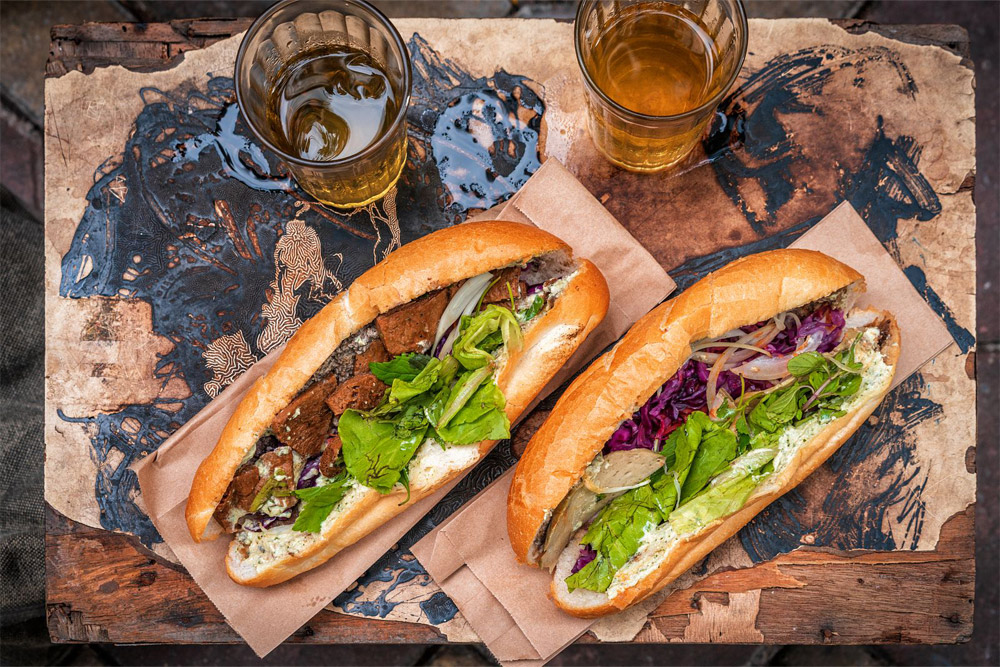
Hanoi’s banh mi is unique for its clean, balanced taste that leans toward savory and umami-rich notes. It’s less sweet and saucy than the Southern version. While Saigon’s banh mi overflows with grilled meats, pickles, and creamy sauces, Hanoi’s version creates a refined flavor harmony with just a few key ingredients.
A traditional Hanoi-style pâté banh mi keeps things simple, just fragrant butter, rich homemade pâté, ruoc (pork floss), xa xiu (char siu), and a touch of chili sauce, salt, and pepper. The flavor leans savory and creamy, with that perfect mix of crunch and softness in every bite.
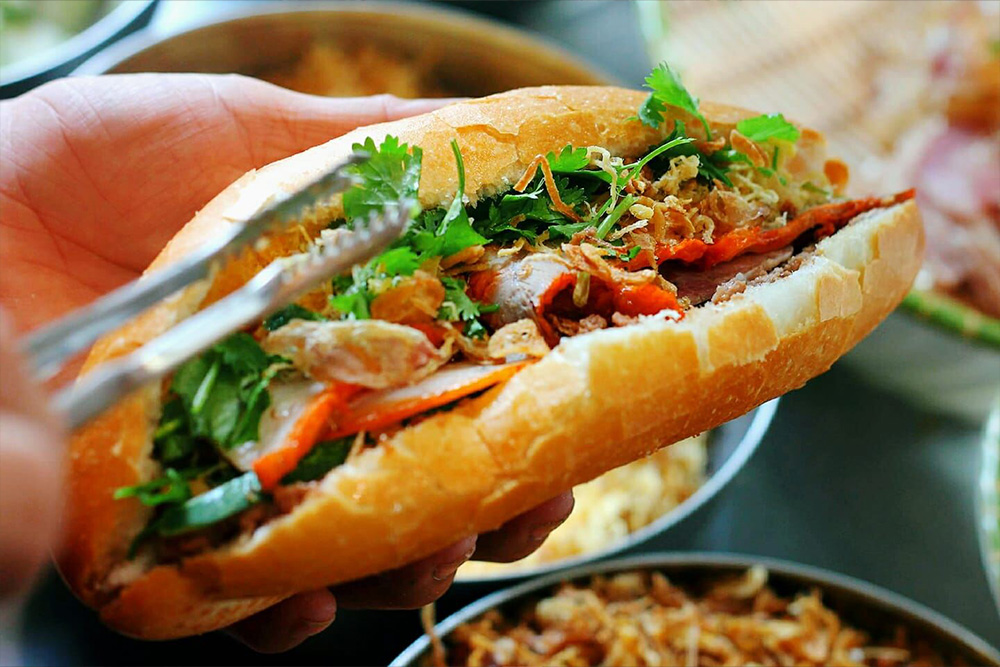
Nowadays, Hanoi’s banh mi scene is wonderfully diverse, offering both timeless classics and creative local twists. Some of the most beloved variations include:
Bánh mì thập cẩm (Mixed Banh Mi) – Very close to the traditional version, the “mixed” banh mi combines multiple fillings like ham, sausage, and pork floss for a hearty bite.
Bánh mì chảo (Pan-Fried Banh Mi Set) – Served alongside a sizzling pan of hot toppings such as eggs, pâté, sausage, beef, and a rich, savory sauce.
Bánh mì thịt xiên nướng (Grilled Pork Skewer Banh Mi) – Grilled pork skewers tucked into warm bread, smoky and irresistible.
Bánh mì que (Mini Stick Banh Mi) – A slim, snack-sized version of the baguette that’s popular as a quick street food. Typically filled with rich pâté, toasted until golden brown, and served with dipping chili sauce
Bánh mì nướng mật ong (Honey-Grilled Banh Mi) – Grilled honey-glazed bread with a fragrant, lightly sweet flavor. Often found at night markets or food stalls, this version skips the meat and focuses on the buttery crunch and caramelized aroma of honey.
Banh Mi Bit Tet (Steak Banh Mi) – A hot, hearty version served with sizzling beef steak, pate, and runny eggs in a pan, often enjoyed with fresh bread on the side. Rich, savory, and perfect for a filling Hanoi-style brunch.
Bánh mì chay (Vegan Banh Mi) – A vegetarian version filled with tofu, mushrooms, or sautéed vegetables, perfect for those seeking a lighter, plant-based option.
Each version offers its own expression of Hanoi’s culinary creativity, yet all share the same soul — a respect for balance, freshness, and flavor harmony. A morning jog around West Lake, followed by a cup of egg coffee and a warm, crispy banh mi — that’s not just breakfast, that’s the timeless charm of Hanoi living.
What to expect as you bite in Hanoi’s banh mi? What makes it different from any other sandwiches you’ve ever tried before? A traditional Hanoi banh mi is a study in balance -every component is carefully chosen to create harmony in flavor and texture.
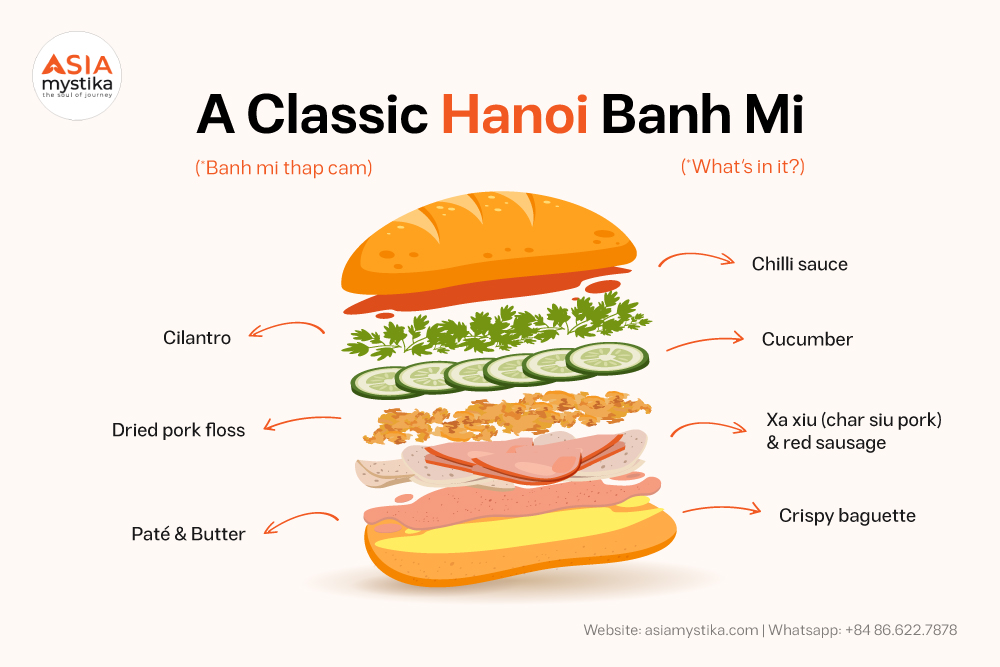
The Bread: The foundation of a great banh mi is the baguette itself. Hanoi’s version is slender, with a thinner, crispier crust that shatters as you bite in, revealing a soft, airy center. It’s baked fresh every morning, often by local bakeries that still follow age-old methods influenced by French tradition.
The Pâté and Butter: This duo forms the heart of banh mi. A thin layer of creamy butter smooths over the bread before a generous spread of rich, homemade pâté. Together, they give the banh mi its signature melt-in-the-mouth flavor.
The Fillings: These days, many shops offer different fillings for you to choose from. The classics include ruoc (pork floss), xa xiu (char siu pork), and red sausage. Other options include fried egg, cha lua (Vietnamese ham), grilled pork belly, chicken, beef, or vegan fillings.
The Vegetables: Simple and subtle. You’ll find only a few slices of cucumber and a small handful of cilantro - just enough to refresh the palate and highlight the richness of the fillings without stealing the spotlight.
The Sauce and Seasoning: Instead of creamy mayo or sweet sauces like in the South, Hanoi banh mi is finished with a mild, fragrant chili sauce and a sprinkle of salt and pepper. The flavor leans savory and slightly tangy - never overwhelming, just the right amount of warmth to tie everything together.
In short, every bite of a Hanoi banh mi is about precision and harmony, a perfect balance of crunch, richness, freshness, and spice that reflects the quiet sophistication of Hanoi’s culinary soul.
If you’re wondering where to find the best banh mi in Hanoi, the city’s streets are packed with tempting options - from humble carts to iconic cafés that draw locals and travelers alike. Below is a curated list of Hanoi’s most loved banh mi shops, each offering a slightly different take on this Vietnamese classic.
No list of banh mi Hanoi Old Quarter favorites is complete without Banh Mi 25, the most famous and tourist-friendly spot in the city, and for good reason. Friendly service, a huge menu for different tastes, including vegan banh mi options. It’s the perfect “first banh mi” experience for newcomers to Hanoi.
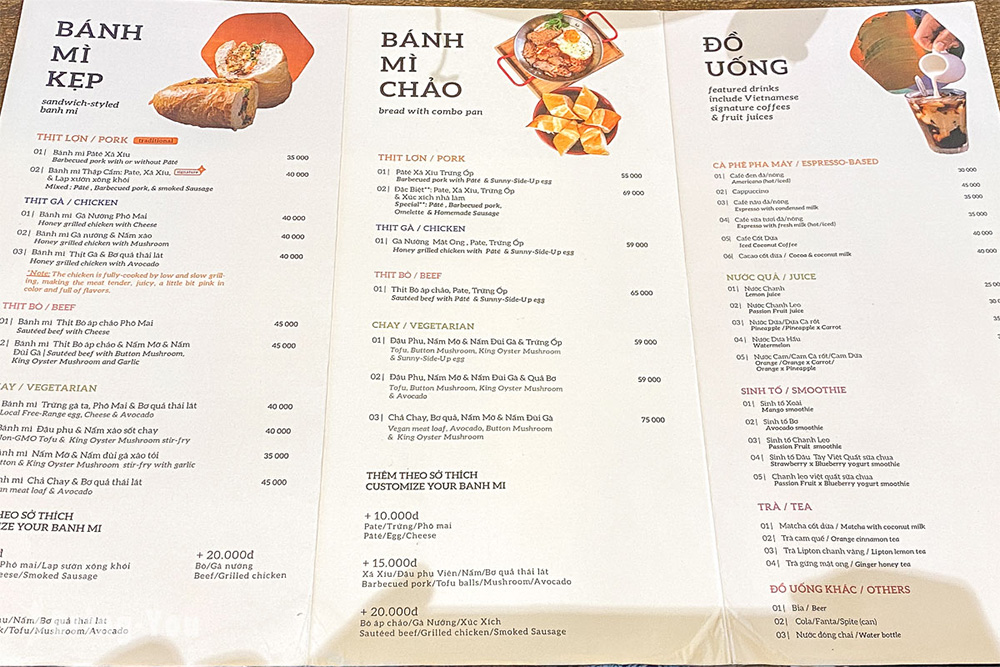
Address: 25 Hang Ca, Hoan Kiem District, Hanoi
Opening Hours: 7:00 AM – 9:00 PM (daily)
See what others say: Banh mi 25 on TripAdvisor
Direction: https://maps.app.goo.gl/wCANMg6g95Sn2dqc9
For those chasing an authentic local banh mi Hanoi experience, head to Banh Mi Tram. There’s nothing fancy here — just a small shop and a sizzling flavor. The signature dish is the banh mi chao (hot-pan banh mi), where fresh bread is dipped into a skillet of warm pâté, egg, and meat. This is where locals eat — no frills, no marketing, just real, old-school flavor.
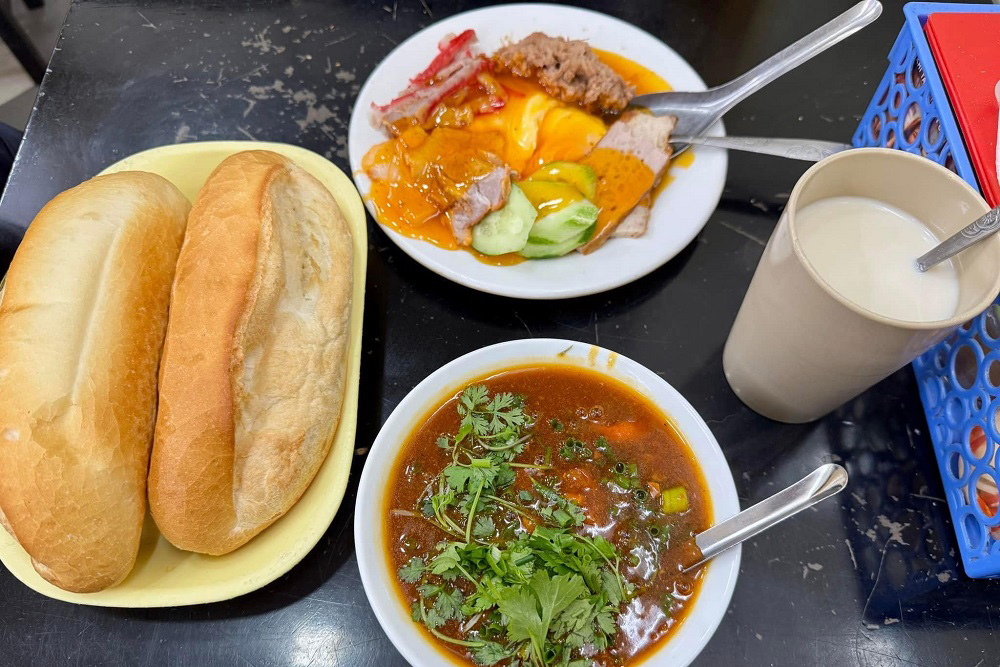
Address: 30 Dinh Ngang, Hoan Kiem District, Hanoi
Opening Hours: 7:00 AM – 10:00 PM (daily)
See what others say: Banh mi Tram on TripAdvisor
Direction: https://maps.app.goo.gl/Fq3MLZRet7C5cUr58
While no banh mi Hanoi shop has received a Michelin award, a few are still worth seeking out for their quality and flavor. One notable example is Banh Mi Hoi An (also known as Bami Bread) — a beloved Central Vietnamese brand that has gained a loyal following in Hanoi. Here, you’ll find the signature Hoi An–style fillings: tender roast pork, pickled papaya, and homemade chili sauce packed inside a perfectly crisp baguette.
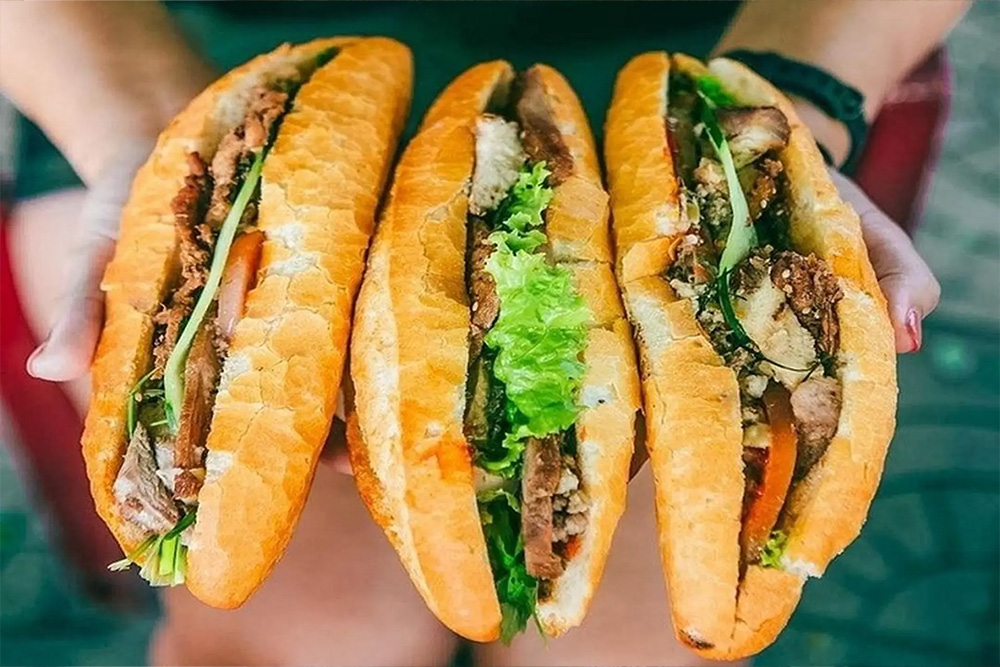
Address: 98 Hang Bac, Hoan Kiem District, Hanoi
Opening Hours: 7:00 AM – 10:00 PM (daily)
See what others say: Bami Bread on TripAdvisor
Direction: https://maps.app.goo.gl/zaNbjYoEZXfQkPFr7
Among travelers who dig into forums for the most authentic banh mi Hanoi, one name pops up again and again — Banh Mi Pho Co. Loved for its thick, creamy pâté and perfectly toasted bread, this spot captures the soul of old Hanoi. A true hidden gem for those who prefer flavor over flash, with crunchy bread, rich pâté, and no unnecessary extras.
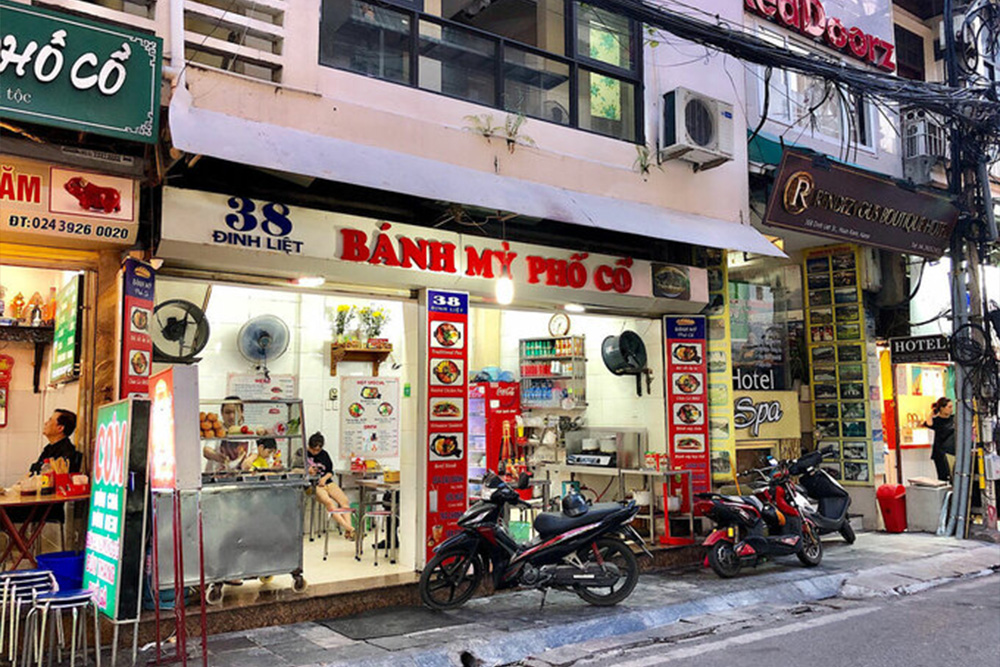
Address: 38 Dinh Liet, Hoan Kiem District, Hanoi
Opening Hours: 7:00 AM – 10:00 PM (daily)
See what others say: Banh Mi Pho Co on TripAdvisor
Direction: https://maps.app.goo.gl/LQayZ6vpdzUsMQoaA
If there’s one place that defines the roots of Hanoi’s banh mi culture, it’s Banh My Nguyen Sinh. Established in the 1940s, this family-run eatery is famous for its French-inspired cold-cut banh mi — layered with house-made pate, ham, and butter. The flavor is old-school Hanoi: rich, elegant, and perfectly balanced.
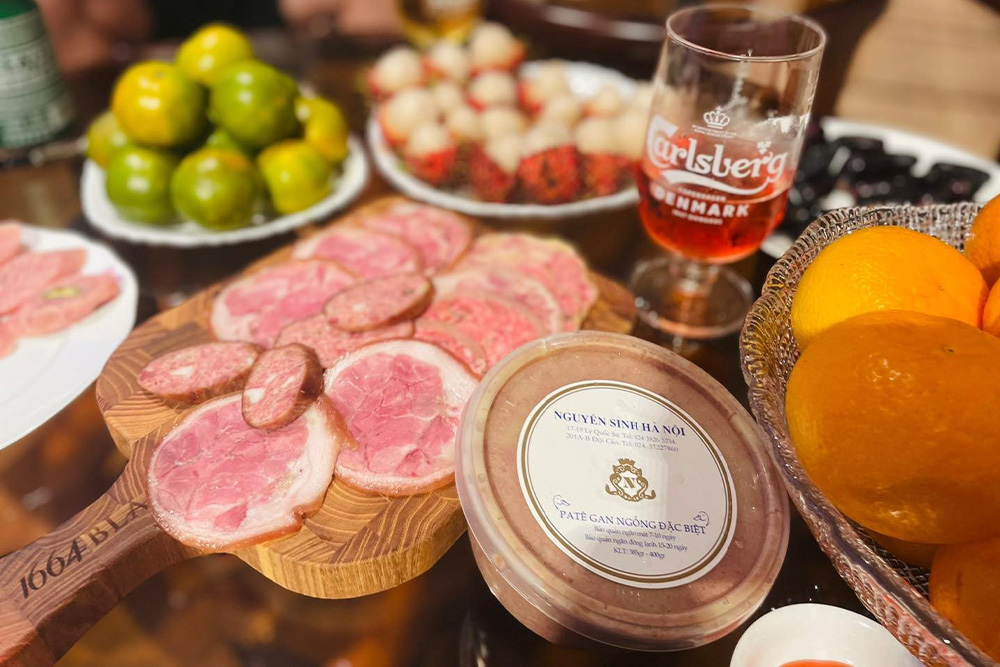
Address: 19 Ly Quoc Su, Hoan Kiem District, Hanoi
Opening Hours: 6:30 AM – 9:30 PM (daily)
See what others say: Banh My Nguyen Sinh on TripAdvisor
Direction: https://maps.app.goo.gl/48hSpRBxGvrrKdFf7
Located right in the Old Quarter, Banh Mi Lan Ong is a longtime local favorite known for its signature homemade pate and crisp, thin baguette. The shop keeps things simple — butter, pate, pork, and a dash of chili — but the flavor is pure Hanoi tradition. Perfect for those who want to taste the city’s authentic morning routine.
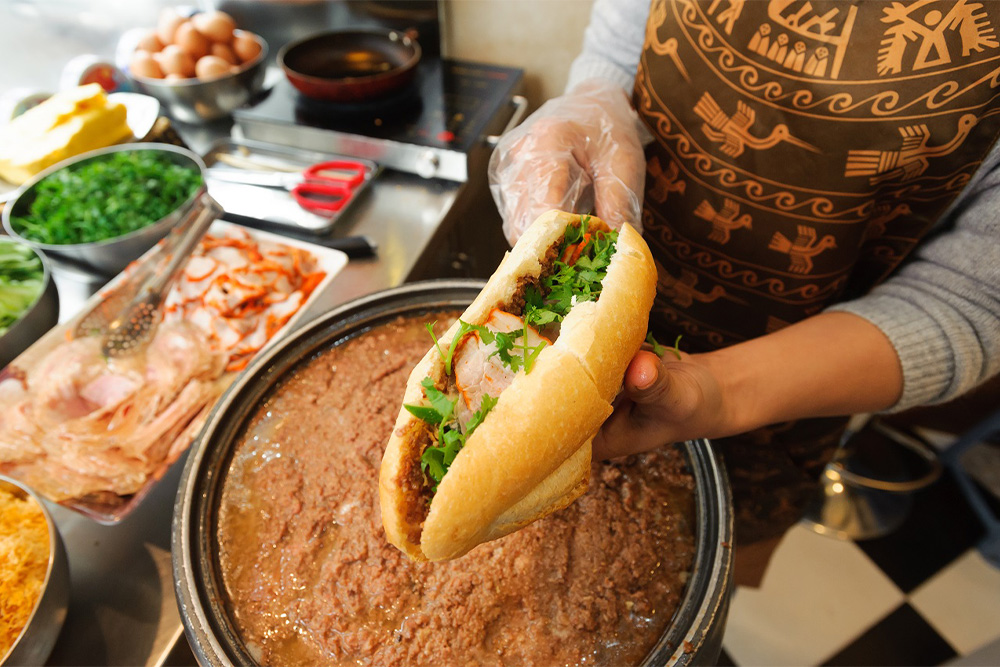
Address: 8 Cha Ca Street, Hoan Kiem District, Hanoi
Opening Hours: 6:00 AM – 11:30 PM (daily)
See what others say: Banh Mi Lan Ong on TripAdvisor
Direction: https://maps.app.goo.gl/VFUANYsBhBfaQedG8
For those who prefer something hot and filling, Banh Mi Bit Tet Ngoc Hieu offers a delicious twist — the famous banh mi chao (bread served with a sizzling steak pan). The combination of runny eggs, beef steak, and rich sauce makes it a local comfort-food favorite. Pair it with a cup of iced tea, and you’ve got a perfect Hanoi brunch.
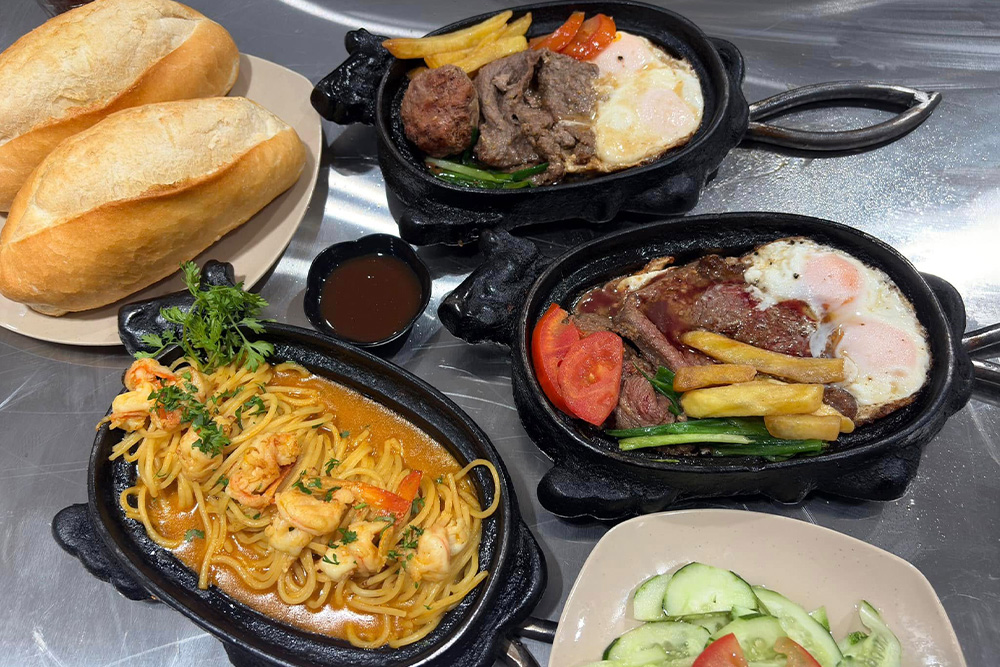
Address: 44 Le Ngoc Han, Hai Ba Trung District, Hanoi
Opening Hours: 7:00 AM – 9:30 PM (daily)
See what others say: Banh Mi Bit Tet Ngoc Hieu on TripAdvisor
Direction: https://maps.app.goo.gl/QpxU5GEMhwkUAxvE9
No discussion of Hanoi street food is complete without Banh Mi Dan To, the city’s most iconic late-night stall. Opening around 2 AM, it draws long queues of locals and night owls craving the signature mix of eggs, pate, ham, and sausage stir-fried together before being stuffed into warm bread. A must-try for adventurous eaters.
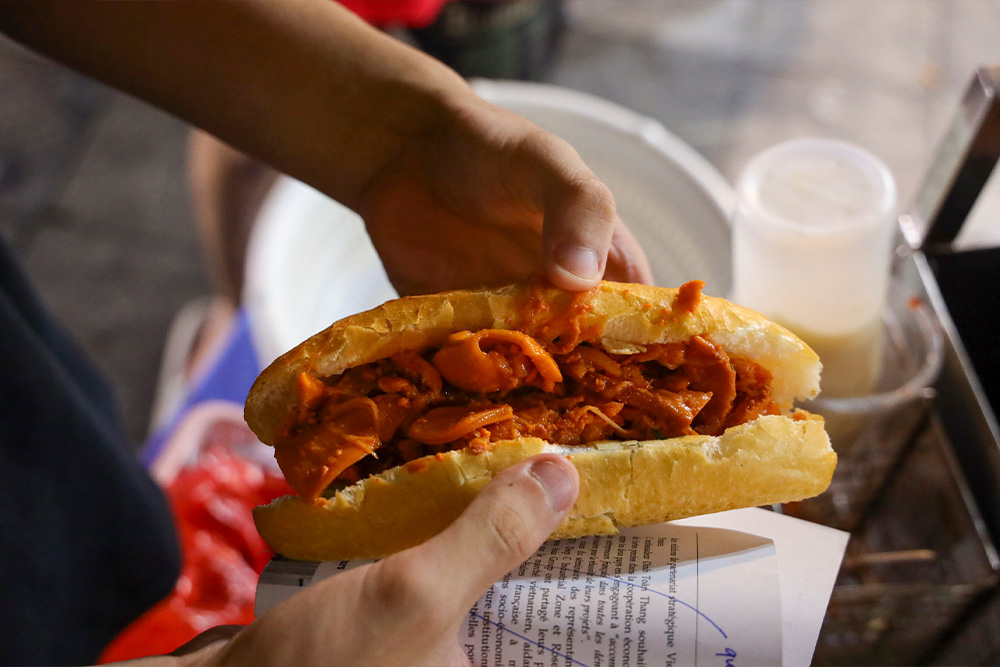
Address: 32 Tran Nhat Duat, Hoan Kiem District, Hanoi
Opening Hours: 6:00 PM – 5:30 AM (daily)
Direction: https://maps.app.goo.gl/2nGZWh8Be14SeJ669
Ordering banh mi in Hanoi is easy once you know a few local tricks — and a couple of Vietnamese words will take you far. Here’s how to sound like a pro when you walk up to a street stall or local bakery.
Know the Lingo
“Bánh Mì Thập Cẩm” /bahn mee tahp kahm/ – The mixed, “everything” banh mi. It’s the safest and most flavorful option for first-timers, with a bit of every topping: pâté, pork, sausage, and herbs.
“Không cay” /khong kai/ – Means “no spicy.” An essential phrase if you’re not used to Vietnamese chili sauce — which can surprise you with its heat.
“Ít rau mùi” /it rau moo-ee/ - Means “less coriander.”
“Không rau mùi” /khong rau moo-ee/ – Means “no coriander.” Say this if you don’t like coriander (cilantro). Locals understand this well, and they’ll happily adjust it for you.
For example, if you want a “everything” banh mi with less coriander and no chilli sauce, simply say something like:
Cho tôi một bánh mì thập cẩm không cay, ít rau mùi. Cảm ơn.
/chaw toy mot bahn mee tahp kahm, khong kai, it rau moo-ee. kahm un/
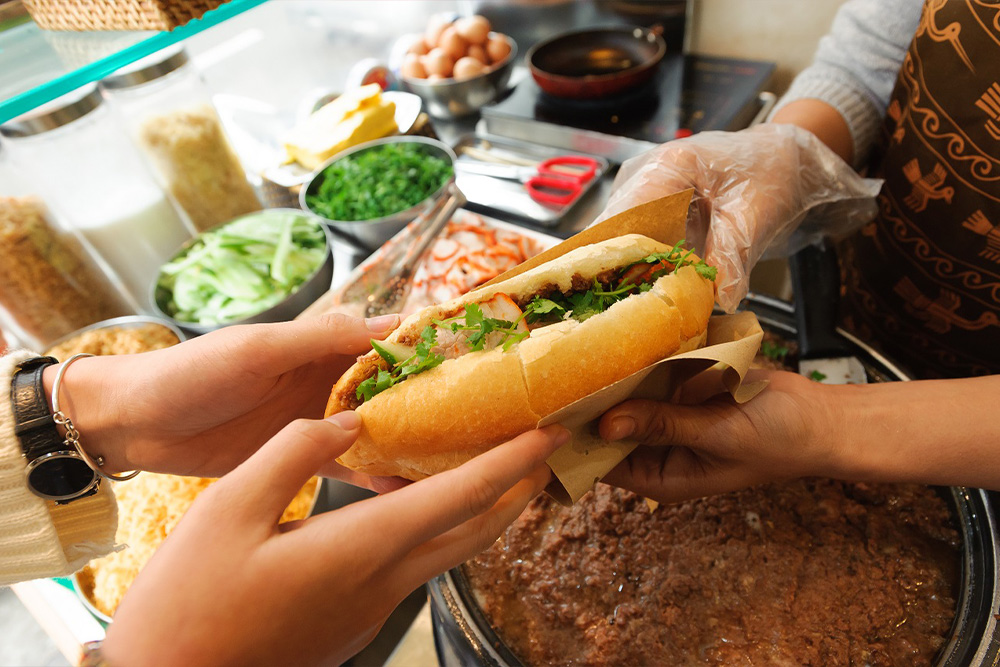
Know the Price
A delicious, authentic banh mi Hanoi shouldn’t break the bank. Expect to pay around 25,000 – 45,000 VND (about 1 – 2 USD) at a local stall. Trendier cafés or Old Quarter shops may charge a little more, but anything above 60,000 VND should come with top-quality fillings and service.
Pro Tip
If you want to experience the best local stalls without worrying about language barriers, join a Hanoi street food tour with Asia Mystika. You’ll get to sample multiple types of banh mi Hanoi, learn how locals customize their sandwiches, and hear the stories behind every bite. Start your custom Hanoi food tour here.
Yes — Hanoi has some of the best banh mi in Vietnam! You’ll find stalls and cafes serving it all across the city, especially in the Old Quarter. Each shop offers its own twist, but the essence of Hanoi’s banh mi lies in its balance of savory pâté, crisp bread, and simple, satisfying fillings.
Hanoi’s banh mi is cleaner and more balanced than its Southern counterpart. It’s less sweet and saucy, focusing instead on umami-rich flavors — buttery baguette, rich pâté, pork, and a touch of chili or salt. Simplicity and balance define the Northern style.
It depends on your taste! Hanoi’s version is more savory and subtle — perfect for those who love refined, balanced flavors. Ho Chi Minh City’s banh mi, on the other hand, is sweeter, richer and creamier, packed with sauces and pickles. Both are delicious — just different regional styles.
It's a heated debate! For a perfect, friendly tourist experience, it's Banh Mi 25. For a more traditional, local taste that focuses on the pâté, many Hanoians would point you to Banh Mi Pho Co.
The Old Quarter is the epicenter. You can't go wrong starting with Banh Mi 25 on Hang Ca street or exploring the smaller stalls on Hang Buom street.
There are no Michelin starred Banh Mi spots. However, a stall named Bánh Mì Hội An, which serves the Central Vietnamese style, is worthy of a name.
Look for a fresh, crispy baguette (you should hear it crackle!), a generous spread of house-made pâté, and a high turnover of local customers—that's always a sign of quality.
Besides banh mi, Hanoi is famous for iconic dishes like pho (noodle soup), bun cha (grilled pork with vermicelli), cha ca (grilled fish with turmeric and dill), and egg coffee. Each captures a different facet of Hanoi’s culinary soul.
The search for the best banh mi Hanoi has to offer is one of the great joys of visiting the city. It’s a journey that takes you through bustling streets and introduces you to the heart of Hanoi food culture - a culture built on fresh ingredients, generations of tradition, and the simple perfection of a humble sandwich.
So, use this guide as your starting point, be adventurous, and get ready to find your favorite. Your perfect Banh Mi is out there waiting for you.
If you want to dive deeper into Hanoi’s local food culture, let Asia Mystika craft a personalized Hanoi food tour just for you. From early-morning banh mi runs to hidden coffee spots and authentic market strolls, we’ll take you beyond the tourist trail — straight into the heart of Hanoi’s flavors. Plan your custom Hanoi food tour with Asia Mystika today.